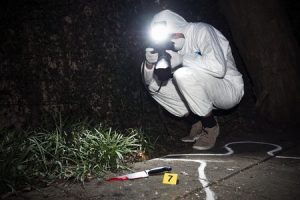Sherlock Holmes was a fictional character created by Sir Arthur Conan Doyle. Originally created for a series of books and novels eventually, the great detective appeared on the small and big screen.
The recent resurrection of the character by Stephen Moffatt and Mark Gatiss, and played by Benedict Cumberbatch, has ignited our interest in how the private detective was seen to solve cases.
In fact, the idea was that Sherlock Holmes and his sidekick Dr Watson could solve crimes by using magic-like powers of deduction, backed by science. There has also been a hint in the modern BBC series that Holmes had high-functioning autism, verging on genius.
Criminology – What is it?
Others suggest that Conan Doyle used a process of deduction and elimination that we still use today.

Many people in modern-day crime detection roles have a broad understanding on criminology and then go on to specialise in certain key areas.
Criminology is the study of all aspects of crime and law enforcement. This includes criminal psychology, the social setting of a crime, prohibition and prevention as well as the investigation and detective methods. It also studies capture and punishment.
There are many people involved – lawmakers, social workers, probation officers, judges, detectives and so on.
Some of the detective means that Conan Doyle has Holmes use to solve crimes are still used today…
#1 Fingerprints
The Sign of Four published in 1890 was the first case in which Conan Doyle included the use of fingerprints in solving a crime. No big deal, you may think, as fingerprinting technology is widely used and understood today.
But what makes this stand out is that Scotland Yard didn’t start to use fingerprinting as part of crime detection until 1901, some 11 years after this story was published.
What makes this even more interesting in that Conan Doyle had Holmes use fingerprints and not a competing forensic theory call ‘bertillonage’. This forensic theory identified and measured the twelve characteristics of the body but Conan Doyle backed the winner, with fingerprinting becoming the preferred forensic method.
#2 Typed Documents
In the age of modern computing, you again may think that again, examining typed print is nothing new. But back when typewriters were common place, Holmes used the small discrepancies between one typewriter and another to detect the criminal.
A Case of Identity was published in 1891 with Holmes solving the crime by comparing the typewriter of the culprit with the letters the victim received. The Federal Bureau of Investigation didn’t start its Document Section analysing this kind of work until 1932, nearly 40 years after Conan Doyle used it.
#3 Handwriting

Criminology is the study of all aspects of crime and law enforcement. This includes criminal psychology, the social setting of a crime, prohibition and prevention as well as the investigation and detective methods. It also studies capture and punishment.
Conan Doyle somewhat exaggerates Holmes’ ability to deduce information from handwritten notes – he can determine gender, whether two note writers are related, determine character and so on.
Although Conan Doyle did over egg this particular subject in the nine stories that featured handwriting analysis, he wasn’t far off the mark.
Today, police and law enforcement agencies regularly review and analyse handwriting. There is also a growing school of thought relating the forensic linguistics and linguistic ‘fingerprinting’, which compares and contrasts the writing of the victim and notes, texts or emails that look to have been written by someone else.
Again, Conan Doyle was years ahead of his time.
#4 What the evidence is telling us
There are times when evidence is in plain sight. In Sherlock Holmes stories, there are frequent references to animals, more specifically dogs.
For example, the police inspector in one story claims that the ‘dog did nothing in the night’. Holmes refers to this as the ‘curious incident of the dog in the night time’, with his suspicions immediately falling on to a culprit.
In another story, a victim’s dog snarled ‘when it shouldn’t’, indicating to Holmes that the culprit was a stranger. In this story, a stranger was masquerading as its mistress and the dog registered distaste and fear by snarling.
In modern crimes, there are many pieces of evidence that act as clues and pointers to who or why a crime was committed. Dogs are used to detect crimes such as buried bodies, counterfeit money, drugs and more.
Studying Criminology
There is no doubt that crime, its detection and prevention is a fast-paced career, enjoyed by many in various roles and guises.
Solving a crime, understanding why it happened and its triggers that give rise to possible prevention methods are studied throughout various Criminology courses online.
Many people in modern-day crime detection roles have a broad understanding on criminology and then go on to specialise in certain key areas.
It is a demanding but rewarding role, with the criminologist being an important cog in the wheel of justice and has been for decades. Is it the right career for you?








